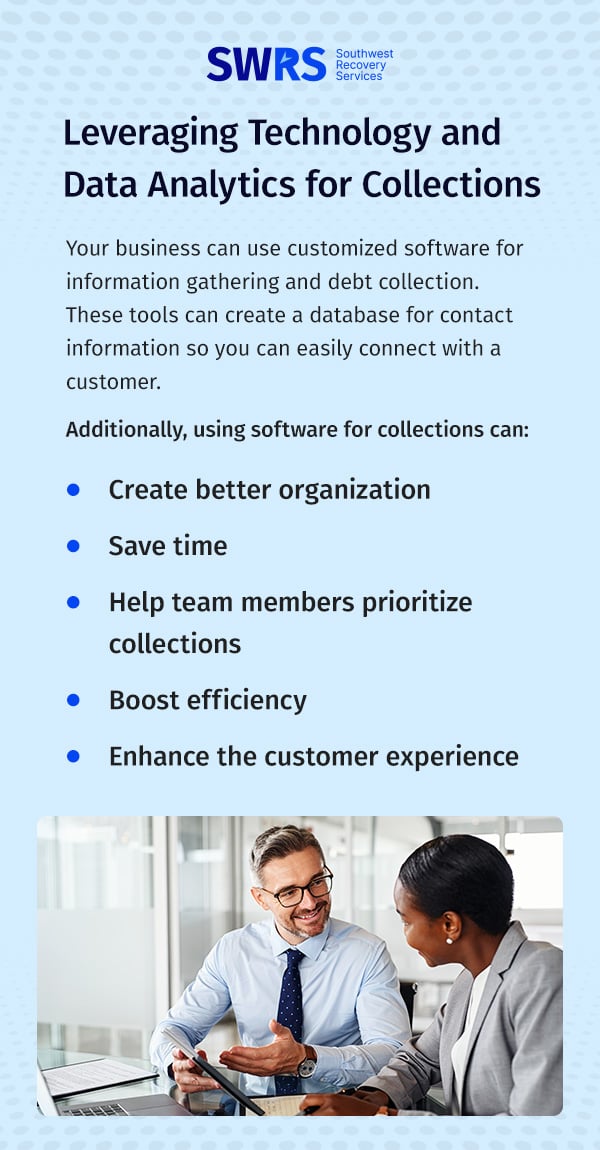- New Customer Inquiries (866) 551-4684
- Customer Service (214) 387-8068
- Make A Payment (866) 558-3328
- Client Portal
- Consumer Support

While many may use the terms debt collection and debt recovery interchangeably because they both relate to collecting unpaid debt, these terms have their own distinct meanings and processes. Collection is when a company seeks late payments from clients, and recovery is when the company reaches out to a third party to receive help recovering the debt.
This guide explains everything you need to know, from the key differences between debt collection and debt recovery to examples, legal compliance and the different strategies for collecting debt.
Let’s say you missed a payment on a product or service a company expects you to pay. Personnel from the company then contact you via email, letter or phone to remind you about the money you owe. This is what debt collection is.
Companies need to get customers to pay their outstanding money because it may slow down their cash flow and harm their reputation. Many large companies have a department that deals specifically with collecting outstanding debt after an invoice is still unpaid after 30 days. These professionals need to handle the situation in particular ways to stay compliant with ethical debt collection laws and regulations.
The debt collection process begins with the business evaluating its accounts receivable, which is the money customers or clients must pay the company on a particular date in the future. If it remains unpaid 30 days after the due date, the business may incorporate a strategy to collect the money. These strategies may sometimes include a dunning letter providing notice to a consumer that their payment is overdue, helping the company prevent delinquent accounts and collect outstanding receivables.
Let’s say the company contacts the consumer several times regarding their overdue payment and still has issues receiving their money from the customer. In these situations, the business may benefit from contacting a reliable third-party organization to act on behalf of the company to recover their unpaid money. Recouping debt through third-party services is commonly known as debt recovery.
Debt recovery differs from debt collection in how it affects the consumer. For example, the third-party debt collection company will record their contact with the consumer, and their debt may impact their credit score. Customers who owe money must ensure they respond to debt collection agencies because ignoring them may only work against them if they end up going to court regarding their debt.
Debt recovery methods begin with the business enlisting the collections agency, which will report the debt to credit agencies or credit bureaus, contact the customer to verify their identity and establish a suitable payment arrangement. If they come across issues doing so, they may pursue legal action to receive the overdue payment with the company’s permission.

While recovery for debt and debt collection aim to reach the same solution (which is to recover overdue payments), key factors set these processes apart:
Various factors may affect how companies and debt collection agencies are able to recover debt, whether that be the type of debt they’re dealing with, the consumer’s financial circumstances or the different legal considerations. Let’s see how these aspects can change the negotiation methods and processes.
The type of debt a consumer has is a common factor that may impact the collection or recovery process and how certain bills are handled. Here are a few types of debt that qualify for recovery and collection:
When a customer has unpaid past-due debt, a company or recovery debt collector may alert the consumer through phone calls or written notices. Let’s consider this example of how the debt recovery and collection processes may differ. If a consumer were to owe money on a student loan and negate paying it, in some instances, the debt collector may use their file information to view personal banking information from savings and investment accounts. This will allow them to determine whether they have the means to repay the debt.
Another example of how the type of debt one has can impact the recovery process is that collectors may be able to add late payments on utilities, medical providers and other services to their credit score even though these types of payments would rarely appear on your credit report.

Whether it’s the company trying to collect their overdue payment or a debt collection agency, the strategy for attaining these funds will always differ based on the customer’s financial situation. This is why communication with this client or customer is essential to get an idea of how they can pay off their debt in a convenient way for both parties.
For instance, they may contact the consumer and discuss the outstanding balance and why they are having issues paying the amount. They may then explore the different payment options based on their conversation. Possible reasons a consumer’s payment hasn’t gone through include:
One of the most important considerations is compliance with the Fair Debt Collection Practices Act (FDCPA). This act outlines the specific information dunning letters should include, the times companies or debt collectors may contact the customer and other laws to comply with. Some of the general legal factors in the FDCPA that require compliance include:
Concerning communication with the consumer, additional laws are in place, including:
There are some other legal factors to keep in mind when businesses or debt collection agencies create a dunning letter. It should include specific information such as:
If you’re a company looking for better strategies to help you recover debt, there are numerous ways you can streamline processes and improve communication with consumers while staying compliant with the relevant laws. Here are six practices you can try during the debt collection process and beyond:
During debt collection, you want customers to feel like they want to find a way to pay you. Show consumers your flexibility when it comes to communicating paying off debt to improve customer engagement during this time.
Many people may only be able to take calls outside of work hours, and while many may prefer a letter or phone, others may prefer an SMS or email. Pay attention to your customers’ personal profiles and personalize communication times and channels according to their preferences to enhance the chances of debt repayment.

An important negotiation strategy to keep in mind is to only negotiate with the person who has the authority to make decisions. For example, you may find it best to speak with the consumer or their lawyer directly rather than a bookkeeper.
You can also try renegotiating a consumer’s debt if you know they are going through an unexpected turn of events, such as a business crisis or the loss of a family member. This means you’ll either arrange a more approachable payback schedule or slightly reduce the amount they owe you.
There are technologies that can take over the simple tasks in the debt collection process and automate them, and they could influence higher repayment rates better than a repeated threatening call. Some artificial intelligence (AI) solutions and chatbots have the ability to choose the appropriate times and channels to reach out to consumers about their repayment. Other technologies may even offer data analytics to monitor and score consumers’ accounts receivable to help them avoid potential risks.
One of the most important things you can do is avoid threatening the customer. This is a prohibited action, according to the FDCPA, and consumers can take legal action against the company if this happens. Instead, while portraying urgency, speak in a way that will encourage the consumer to stay positive and discuss the debt more calmly and professionally. Once you have come to a decision, confirm the agreement in writing or by email so you can refer to them in the future.
Another factor that may be significantly beneficial is informing your consumer of their rights and obligations as someone with outstanding payments. You may also explain to them why this matters to you and what your company’s obligations are so if the situation requires recovery later, the process is more straightforward, and consumers are well aware of their rights.
If your debt collection process is unsuccessful, work with a reputable third-party recovery agency to help you recover your funds. These organizations are well aware of all the compliance and collection laws, and they have effective debt recovery strategies to help protect your cash flow and brand reputation.
Now that we know the legal factors to consider and best practices to implement, let’s get you started on debt collection. Here are a few effective examples of debt collection letters you may send to any consumers with outstanding payments:
Debt collection and debt recovery are equally important processes that require effective strategies and compliance with government regulations to recover payments owed to a company.
Are you having debt collection issues? We encourage you to work with a capable and professional debt collection company like Southwest Recovery Services. Our experts offer creative recovery solutions on a contingency basis — meaning you’ll only need to pay us if we get your consumers to repay you! For assistance from a certified third-party collection company, contact Southwest Recovery Services today!


We make it fast and easy to refer past due and delinquent accounts to our professional recovery agents. You decide the range on what you will accept on each case, and you ONLY pay a percentage of what we actually collect to resolve the case. Ready to get started, or want to learn more? Fill out this form and a dedicate account manager will call you to get started.